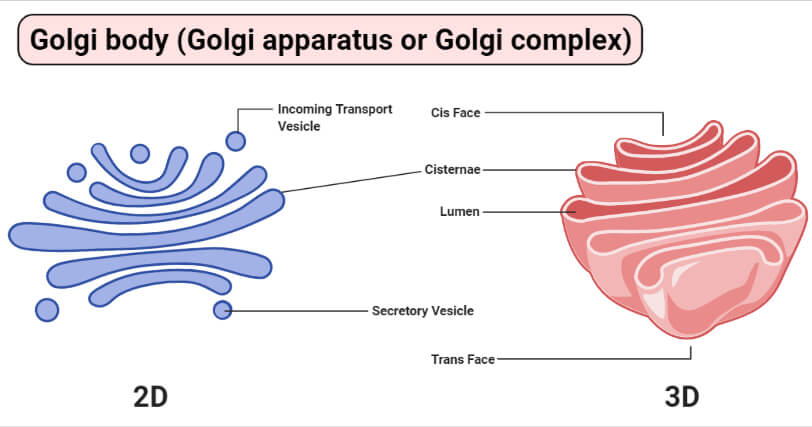Golgi body or complex is an organelle that is bound by a membrane in eukaryotic cells.
- The Golgi body is also called as Golgi apparatus, Golgi complex, lipochondrion, Barker’s body, Dalton Complex, and Apparato Reticulare.
- Golgi complex may have distinct subunits called Golgiosomes, idiosomes, or dictyosomes.
- It is called dictyosomes, in plants and lower invertebrates.
- The flattened, stacked pouches known as cisternae are present in it.
- The Golgi apparatus transports, modify and packs the proteins as well as lipids into vesicles.
- Then, it delivers them to targeted places.
- The Golgi body is situated in the cytoplasm which is next to the endoplasmic reticulum. Similarly, it is closer to the cell nucleus.
- Different types of cells contain only one or more Golgi apparatus but plant cells can contain it abundantly which might be in hundred.
- It is not found in prokaryotic cells. Examples: PPLO, bacteria, and blue-green algae.
- It is found in all eukaryotic cells except:
- sieve tubes of plants
- sperms of bryophytes and pteridophytes
- red blood cell of animals
- The Golgi body had been first seen by George (1867).
- The Golgi body was observed in 1898 by Camillo Golgi in the nerve cells of owl and cat. He was a cytologist from Italy. It is named after him.
- In Golgi’s early studies of nerve tissue, he had established a staining technique. He mentioned it as reazione near. It is called the black reaction. Nowadays, it’s said as the Golgi stain.
- During this technique nerve tissue is fixed with potassium dichromate. It is then suffused with silver nitrate.
- In the 1950s, when the microscope was started to use, the study and the presence of the Golgi body were confirmed.
- In 1954 Dalton and Felix studied its structure under a microscope
- The Golgi body is surrounded by an organelle-free cytoplasm called the zone of exclusion. It is also called a Golgi ground substance.
Interesting Science Videos
Structure of Golgi body
- The shape and size of the Golgi body aren’t fixed.
- They depend on the physiological condition of the cells.
- Usually, the Golgi body is formed from four parts. They are:
- Cisternae
- Tubules
- Vesicles
- Vacuoles
a. Cisternae
- Generally, the Golgi body is formed from nearly four to eight cisternae.
- But in some single-celled organisms, it may contain as many as 60 cisternae.
- Matrix proteins hold the cisternae, and therefore the whole of the Golgi body is supported by cytoplasmic microtubules.
- Golgi apparatus consists of a stack of generally 4-8 membrane-bound saccules or cisternae.
- In fungi, unicisternal dictyosomes are present.
- The cisternae have a smooth membrane.
- But they are of variable thickness.
- They enclose the lumen.
- It contains a fluid which is also called a matrix.
- The thin layer of cytoplasm is present in the intercisternal space. It has parallel fibrils.
- Each cisterna is the functional unit of the Golgi complex.
- The margins of each cistern are frequently curved.
- The saccules are frequently curved to give a particular polarity to the Golgi body.
- One face of the apparatus is convex.
- The other face of the apparatus is concave.
- The convex side is present in the proximal end which is called forming face or cis-face.
- It is directed towards the nucleus.
- At this end, cisternae constantly receive vesicles (also called transitional vesicles) from the smooth endoplasmic reticulum.
- The concave side of the apparatus is called the maturing face (trans-face).
- The concave face or distal face cisternae is present towards the plasma membrane.
- The thickness of the maturing face is 7-8 nm.
- In the case of the forming face, they are about 4 nm in thickness.
- Their contents undergo various cisternae with the assistance of coated vesicles and intercisternal connectives.
- They ultimately reach the maturing face where they’re budded off as secretion, coated or Golgian vesicles, or vacuoles.

b. Tubules
- They are short and branched.
- The tubules interconnect the various cisternae.
- They form a sophisticated network towards the periphery and maturing face of the apparatus.
- Tubules arise because of fenestrations of the cisternae.
- The diameter is generally 30-50 nm.
- They are mainly involved in the elaboration of secretory products.
c. Vesicles
- They are small sacs of 20-80 nm diameters that develop from tubules.
- The vesicles are found attached to the tips of tubules at various levels within the network.
- They’re of two types: Coated and smooth vesicles.
i. Coated vesicles
- The coated vesicles have a rough surface.
- Fine bristle-like outgrowths cover the coated vesicles.
- They bud off from the ends of peripheral tubules and pass into the cell membrane and helps in endocytosis.
- They elaborate membrane proteins.
ii. Smooth vesicles
- The smooth vesicles have a smooth surface.
- They contain secretory substances and are hence called secretory vesicles.
- They bud off from the tubules within the network.
- On being pinched off, they pass into the cell membrane and help in exocytosis.
d. Golgian vacuoles
- They are round vesicles or sacs which are enlarged parts of the cisternae.
- They became modified to make vacuoles.
- From the concave or maturing face of distal sacisternae, the vacuoles get developed.
- Golgian vacuoles contain amorphous or granular substances.
- Golgian vacuoles also function as lysosomes.
Functions of Golgi body
- The major role of the Golgi complex is secretion. It secrets gum, mucus, sweat, tears, saliva, etc.
- From the Endoplasmic reticulum proteins, pro-enzymes, lipids, steroids, and other substances pass to the Golgi complex.
- It may occur directly or through the agency of transitional vesicles.
- Golgi complex concentrates, modifies, and packages these bio-chemicals into the secretion vesicles.
- It later pinches off and passes out the secretory bio-chemicals through exocytosis or reverse pinocytosis.
- It helps in the transformation of one type of membrane into another type.
- It converts the membrane of the endoplasmic membrane into the selectively permeable plasma membrane, the differentiated membrane of the lysosome, etc.
- It also helps in recycling the cell membrane.
- In the plant cells, a cell plate is formed in the middle of the dividing cell. It happens when the vesicles get fused which is produced by the Golgi complex.
- Golgi complex stores, condense packs and transports various substances.
- The digestive enzyme obtained through the endoplasmic reticulum is stored by some of the vesicles or vacuoles of the Golgi complex.
- Vesicles of the Golgi complex forms the acrosome of sperms.
- It helps in the formation of the root hairs by their mother cells.
- The membrane of the vesicle of the Golgi complex helps the formation of plasma membrane after cytokinesis.
References for Golgi body
- Shakya M, Mehata KR, Gautam MK, Pokhrel KR and Khanal K (2020 ) “ Principles of Biology”, Asmita Books Publisher and Distributors Ltd, Bhotahity, Nepal
- https://www.biologydiscussion.com/cell/golgi-apparatus/golgi-apparatus-meaning-structure-and-functions/70510- 30%
- https://www.britannica.com/science/Golgi-apparatus- 12%
- https://answers.yahoo.com/question/index?qid=20110704122532AAXDskv– 1%
